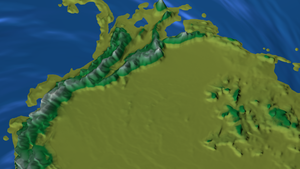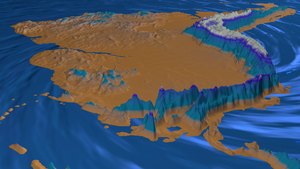User:Catalina/Proposal
Time machine: ice ages in the Andes or Sky Islands in the Andes Mountains
INTRODUCTION
Research Question?
Definition of the research?
Context
Describe the process in comparison with other works
Conclusion
What do you want to make?
I want to explore 3D animation and data visualization as the contemporary tools to imagine ecosystems in time and space. I feel that visual art communication is a powerful instrument to create awareness about the importance of ecosystems, biodiversity and wildlife. In the same way, Science and Arts overlap each other by giving shape to a new creation that enlightens insights, triggers our imagination and helps putting ideas in a new perspective. Especially subjects that are complex in multiple dimensions can highly benefit from the integration between theoretical knowledge and modeling with simulations and science visualization, shaping our sensory experience on something that by definition can neither be touched nor seen (Francoeur, 1997).
I’d like to know more about the project. Is it a installation? How would it work?
Why?
A group of several researchers from Colombia and Netherlands have been using, for about 50 years, pollen fossil as a tool to have an approximation about ecosystems and climate in the past. Pollen grains, that have been preserved thousands of years in the mountain lakes, are a unique fossil witnesses that tell us the story of how the vegetation and ecosystems changes in time. Nowadays, we know the Andes has been pushed by the Pleistocene glacial-interglacial periods to move their ecosystems rhythmically up and down along the slopes. We know that every 100.000 years an Ice glacial era allowed the expansion of Andean Paramo's species while their contrary interglacial era divided the paramos into isolated areas as sky islands. These continuous changes are known recently as "flickering connectivity system" in the tropical South America mountains.
I want to transform this information, already available to communicate in a visual form the changes that ecosystems and vegetation of the Northern Andes for the last glacial cycles (1 Million Years before present). This is a proposal to launch a Science & Art collaborative project that aims at creating a visualization of the Pleistocene geological era history of alpine ecosystems through the use of digital 3D-animation. The story framework line is driven by climate change and how the páramo ‘sky islands’ shifted altitudinaly along the mountain slopes, heavily influenced by the topography that determined to which degree the páramo got fragmented into isolated patches.(this following sentence is more like "how do u make it"?) I use the ‘páramos’ of the Northern Andes as a case study area, supported by unique long fossil pollen records (e.g. Torres et al., 2005, 2013; Groot et al., 2011, 2013), preliminary work on understanding the spatial dynamics of Andean biomes (Flantua et al., 2014), and previously developed conceptual frameworks (Van der Hammen 1974 , Flantua & Hooghiemstra, 2017). I believe it will be a political and educational tool to make Ecological decisions, I am sure that visualizing the past we will understand the present and we will take decisions about the future of the planet. The visualization will be relevant for a very large public including scientists, students, universities, new media artists, schools, policy makers and governments.
How do you want to make it?
I want to make a video installation and mapping projection using 3d animation. I want to create a time machine to travel in the past times of Andes mountains to see how the ecosystems and plants evolved in time. I have two ideas:
1.If it is possible display with several projectors in a 360 degrees screen as a immersive projection. 2. Display with two different screens: one will show a close up in the mountains and the second one in front, will show the Earth and Sun's cycles from outside of the planet.
How do you transfer data to visual? Resources of data?
Who can help you or how?
This is collaboration project with the research team of Palaeoecology at the Institute of Biodiversity and Ecosystem Dynamics, University of Amsterdam, which will be supported by Science PhD. Suzette Flantua and Professor Henry Hooghiemstra. They will provide advice in science research, data and publications that will be the core of the visualization script and story. As well I will have the support of Arts advisors at Piet Zwart Institute as Simon, Barren, Javier, David, Hina, Steve and some professors at Willem de Kooning Academy for data visualization work.
Relation to a larger context?
In a larger context sense, the piece would be outlined inside the conceptual movement of artists exploring the metaphorical language of Planet Earth which started in the 70's, like “Planet Earth in Contemporary Electronic Artworks” and “Environmental Art”, which expression coined as an umbrella term to encompass Eco-Art/Ecological Art, Ecoventions, Land Art, Earth Art, Earthworks, and Art in Nature (Knebusch, 2004; Bower 2010). To bring some examples for Environmental Art, there are over 150 artists, and close to 22 scientists and Science & Arts collaborative projects, organizations, programs, and residencies focused on this Eco-Art movement around the world (The Greenmuseum, 2010); a number that have been increasing with the current ‘Art in the Anthropocene”, a massive trans-disciplinary movement of artists, designers and scholars exploring the symbolic language of the Anthropocene (Anthropocene Agents 2017). Artists since the 70’s that have been engaging audiences for climate change, restoration of ecosystems and protection of watersheds using models for sustainable restoration are Newton & Helen Mayer Harrison, AMD&ART/ T., Allan Comp, Jean Paul Ganem, Tim Collins & Reiko Goto, Yolanda Gutiérrez, Patricia Johanson, Lynne Hull, Ichi Ikeda and Aviva Rahmani.
To bring some of the most recent examples of events created to engage audiences for environmental issues in the framework of Anthropocene are:
1) ‘The Great Acceleration: Art in the Anthropocene’ at Taipei Biennale (2014) with the participation of 52 artists (http://www.taipeibiennial.org:8080/index.php/en/). As Bourriaud described (2014), the exhibition addressed the cross-overs appearing in the art of the Anthropocene; it was focused on artists for whom objects, products, computers, screens, chemistry, natural elements or living organisms are interconnected with humans, and can be used by them for a critical analysis of contemporary world. The exhibition highlighted the way artists focus on links, chaining, connections and mutations: how they envision planet earth as a huge network, where new states of matter and new forms of relations appear (Dickinson, 2015; Lin, 2015).
2) ‘7 MIL MILLONES’ (http://www.eacc.es/7-000-000-000/info/) referred to the total human population inhabiting Earth and was hosted at EACC in Valencia, Spain (Alonso, 2015).
3) ‘Dark Ecology project’ (2014, 2015, 2016) inspired by Timothy Morton’s concept of ‘Dark Ecology’ and his philosophy of ‘Ecology without Nature’. Morton offers a radical criticism of the modernist way of thinking about nature as something outside of us and instead proposes an interconnected “mesh” of all living and non-living objects (http://www.darkecology.net/about).
Timetable
October-December January-March April-June
References
Alonso C. (2015). Artistic practices, discursive contexts and environmental humanities in the Age of the Anthropocene. Artnodes 15, I ISSN 1695-5951.
Bourriaud, N. (2014). The great acceleration. Art in the Anthropocene. http://www.taipeibiennial.org:8080/index.php/en/tb2014?phpMyAdmin=ef6946252cea3105a72033fb2f279321. (accessed 18-04-2017).
Bower, S. (2010). A Profusion of Terms. Greenmuseum.org. URL: http://greenmuseum.org/generic_content.php?ct_id=306. (accessed 06-04-2017).
Dickinson, B. (2015). Pleistocene, Holocene, Anthropocene. Features 02, ART MONTHLY, Sep 15, 389 pg.
Flantua, S.G.A., Hooghiemstra, H., Van Boxel, J.H., Cabrera, M., González-Carranza, Z., González-Arango, C. (2014). Connectivity dynamics since the Last Glacial Maximum in the northern Andes; a pollen-driven framework to assess potential migration, in: Stevens, W.D., Montiel, O.M., Raven, P.H. (Eds.), Paleobotany and Biogeography: A Festschrift for Alan Graham in His 80th Year. Missouri Botanical Garden, St. Louis, pp. 98–123.
Flantua, S.G.A. & Hooghiemstra, H. (2017) Historical connectivity and mountain biodiversity. In: Hoorn, C., Perrigo, A., Antonelli, A. (eds). Mountains, Climate and Biodiversity. Wiley, Oxford, UK.
Francoeur, E. (1997). The Forgotten Tool: The Design and Use of Molecular Models. Social Studies of Science. 27(1), 7-40.
Groot, M.H.M., Bogotá, R.G. Lourens, L.J., Hooghiemstra, H., Vriend, M., Berrio, J.C., Tuenter, E., Van der Plicht, J.H., Van Geel, B., Ziegler, M., Weber, S.L., and 14 Fúquene Project Members (2011) Ultra-high resolution pollen record from the northern Andes reveals rapid shifts in montane climates within the last two glacial cycles. Climates of the Past 7, 299-316. DOI: 10.5194.cp-7-299-2011.
Groot M.H.M., Hooghiemstra, H., Berrio, J.C., and Giraldo, C. (2013). North Andean environmental and climatic change at orbital to submillennial time-scales: vegetation, water levels and sedimentary regimes from Lake Fúquene 130–27 ka. Review of Palaeobotany and Palynology 197, 186–204.
Knebusch, J. (2004). Planet Earth in Contemporary Electronic Artworks. Leonardo 37 (1), 18-24. URL: http://muse.jhu.edu/journals/len/summary/v037/37.1knebusch.html (accessed 06-04-2017).
Lin, A. (2015). Taipei Biennial: The Great Acceleration. Art Review Issue. Taipei Fine Arts Museum. Jan & Feb 2015. URL: https://artreview.com/reviews/jan_feb_2015_review_taipei_biennial/ (accessed 06-04-2017).
Symposium Agents in the Anthropocene: Trans/disciplinary practices in art and design education today. (2017).Piet Zwart Institute / Willem de Kooning Academy, Rotterdam. January 27-28, 2017. https://www.anthropoceneagents.nl (accessed 04-18-2017).
The Greenmuseum org (2010). URL: http://www.greenmuseum.org/. (accessed 06-04-2017).
Torres, V., Vandenberghe, J., Hooghiemstra, H. (2005). An environmental reconstruction of the sediment infill of the Bogotá basin (Colombia) during the last 3 million years from abiotic and biotic proxies. Palaeogeography, Palaeoclimatology, Palaeoecology 226, 127–148. doi:10.1016/j.palaeo.2005.05.005
Torres, V., Hooghiemstra, H., Lourens, L., Tzedakis, P.C. (2013). Astronomical tuning of long pollen records reveals the dynamic history of montane biomes and lake levels in the tropical high Andes during the Quaternary. Quaternary Science Reviews 63, 59–72. doi:10.1016/j.quascirev.2012.11.004
Van der Hammen, T. (1974) The Pleistocene changes of vegetation and climate in tropical South America. Journal of Biogeography 1, 3-26.



